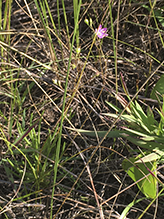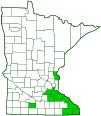rough-seeded fameflower
(Phemeranthus rugospermus)
Conservation • Description • Habitat • Ecology • Use • Distribution • Taxonomy
Conservation Status |
|
|||||||
| IUCN Red List | not listed |
|||||||
| NatureServe | N3N4 - Vulnerable to Apparently Secure S2 - Imperiled |
|||||||
| Minnesota | Threatened |
|||||||
Description |
||
Rough-seeded fameflower is a small, often overlooked, early summer wildflower. It occurs in the United States from Wisconsin, Indiana, and Louisiana west to Minnesota, Nebraska, and Texas. It is spotty and localized throughout its range. It is rare in Minnesota, where it is mostly restricted to the southeast and the southern Metro regions. There is a single record from Watonwan County reported on BONAP, and an historical record from Chisago County where it may no longer occur. It is found in dry, open areas with little competition from other plants, including on cliffs, rock outcrops, sand dunes, riverbanks, and prairies. It grows under full sun in sandy soil. In Minnesota it blooms from mid-June to mid-July. When not in bloom the plant is inconspicuous and easily overlooked. Rough-seeded fameflower is a 4″ to 10″ (10 to 25 cm) tall, erect, perennial forb that rises on a single short stem from a short taproot and more or less fleshy roots. The taproot is unbranched but with age develops additional crowns, and one stem will rise from each crown. The stem is erect, succulent, and hairless. It is unbranched below the middle, sometimes branched above. Numerous alternate, stalkless leaves are crowded at the base of the stem, sometimes appearing like a rosette. The blades are succulent, almost round in cross section, and 1¼″ to 2⅜″ (3 to 6 cm) long. The inflorescence is a branched, flat-topped cluster (cyme) of several flowers at the end of the stem. The cyme is 4″ to 8″ (1 to 2 dm) long, including the leafless, scape-like stalk (peduncle) that is up to 6″ (15 cm) long. The branches of the cyme have opposite pairs of tiny, lance-shaped, modified leaves (bracts). Each flower is about ½″ (12 mm) wide. There are 2 outer floral leaves (sepals), 5 petals, 12 to 28 stamens, and 1 style. The sepals light green, egg-shaped, and ⅛″ (4 mm) long. The petals are pink to magenta, egg-shaped to inversely egg-shaped, and ¼″ to 5⁄16″ (6 to 8 mm) long. The upper third or half of the style is divided into 3 linear, widely spreading stigmas. Each flower lasts just a single day, and is open for only a few hours in the late afternoon. The fruit is a globe-shaped, ⅛″ to 3 ⁄16″ (4 to 5 mm) long, one-chambered capsule with many seeds. The seeds are 1⁄32″ (1.2 mm) in diameter, minutely roughened, and strongly wrinkled. This is the feature that gives the plant its common name. |
||
Height |
||
4″ to 10″ (10 to 25 cm) |
||
Flower Color |
||
Pink to magenta |
||
Similar Species |
||
Habitat |
||
Dry, open areas with little competition from other plants. Cliffs, rock outcrops, sand dunes, riverbanks, and prairies. Full sun. Sandy soil. |
||
Ecology |
||
Flowering |
||
mid-June to mid-July |
||
Pests and Diseases |
||
|
||
Use |
||
|
||
Distribution |
||||
|
Sources |
|||
| 11/6/2021 | ||||
Nativity |
||||
Native |
||||
Occurrence |
||||
Rare and local |
||||
Taxonomy |
|||
| Kingdom | Plantae (green algae and land plants) | ||
| Subkingdom | Viridiplantae (green plants) | ||
| Infrakingdom | Streptophyta (land plants and green algae) | ||
| Superdivision | Embryophyta (land plants) | ||
| Division | Tracheophyta (vascular plants) | ||
| Subdivision | Spermatophytina (seed plants) | ||
| Class | Magnoliopsida (flowering plants) | ||
| Subclass | Rosidae | ||
| Superorder | Caryophyllanae | ||
Order |
Caryophyllales (pinks, cactuses, and allies) | ||
Family |
Montiaceae (pussypaw) | ||
Genus |
Phemeranthus (fameflowers) | ||
Subordinate Taxa |
|||
|
|||
Synonyms |
|||
Talinum rugospermum |
|||
Common Names |
|||
prairie fameflower prairie fame-flower rough-seeded fameflower rough-seeded fame-flower roughseed fameflower sand fame-flower |
|||
Glossary
Bract
Modified leaf at the base of a flower stalk, flower cluster, or inflorescence.
Cyme
A branched, flat-topped or convex flower cluster in which the terminal flower opens first and the outermost flowers open last.
Scape
In plants: An erect, leafless stalk growing from the rootstock and supporting a flower or a flower cluster. In insects: The basal segment of the antenna.
Sepal
An outer floral leaf, usually green but sometimes colored, at the base of a flower.
Stigma
In plants, the portion of the female part of the flower that is receptive to pollen. In Lepidoptera, an area of specialized scent scales on the forewing of some skippers, hairstreaks, and moths. In other insects, a thickened, dark, or opaque cell on the leading edge of the wing.
Visitor Photos |
|||||
Share your photo of this plant. |
|||||
| This button not working for you? Simply email us at info@MinnesotaSeasons.com. Attach one or more photos and, if you like, a caption. |
|||||
Nancy Falkum |
|||||
cartway by cottonwood dump |
|||||
 |
|||||
MinnesotaSeasons.com Photos |
|||||
|
|||||

Slideshows |
||

Visitor Videos |
|||
Share your video of this plant. |
|||
| This button not working for you? Simply email us at info@MinnesotaSeasons.com. Attach a video, a YouTube link, or a cloud storage link. |
|||
Other Videos |
|||
| Fame Flower Bloom Time Lapse craimond513 |
|||
About
Jul 8, 2016 Prairie Fame Flower (Phemeranthus rugospermus) flowers opening. This species' flowers only open in the late afternoon at the hottest part of the day. These ones started opening at around 4:30pm and were fully open by 5:00pm. This species is an uncommon sand barrens resident. Video taken in Sauk County Wisconsin 8 July 2016. |
|||

Created: 11/6/2021
Last Updated:


